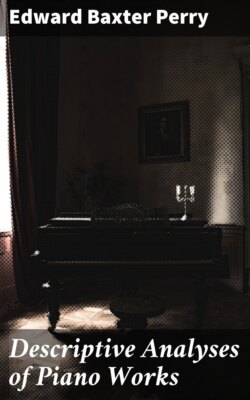Читать книгу Descriptive Analyses of Piano Works - Edward Baxter Perry - Страница 11
На сайте Литреса книга снята с продажи.
Beethoven: Sonata, C Major, Op. 53
ОглавлениеTable of Contents
This is one of the best and justly most beloved of the pianoforte works from what is known as Beethoven’s Second Period; that is to say, the period when his creative power was at its zenith, when his genius had reached its fullest maturity, yet showed no sign of waning; when, in its individual development, it had outgrown all youthful crudities, all reminiscent suggestions of older masters, occasionally to be found in his earlier writings, yet before it had lapsed into that somewhat obstruse, metaphysical vein to which some of us are inclined to object in his latest works, in which individuality is sometimes exaggerated into eccentricity. The present writer is not among those who regard his latest sonatas for the piano as in any sense his greatest works, and it is something of a question whether any pianist would play or any audience tolerate the Op. 111, for instance, if it bore any signature but that of Beethoven. The works of his second or middle period are instinct with far more genuine spontaneity and true musical effect.
The Op. 53 is familiarly known among musicians under two names. It is often designated as the “Aurora Sonata,” because of its suggestive reference to, not to say actual description of, those wondrous fireworks of the heavens, the northern lights. The first movement particularly, with its constant change of key, its well-nigh infinite variety of light and shade, above all, its constant flash and play of scintillating embellishment and brilliant passage work, cannot fail to call up before the imaginative mind the varying hues, the shifting, intermittent splendors of the aurora borealis, with its flashes of crimson and orange, and its flickerings of softest violet and rose.
The second movement forms a distinct and restful contrast and quiet background to the brilliancy of the first. It is slow, reposeful, and gravely impressive, symbolizing the hushed solemnity of the quiet, frost-clear, winter night.
The last movement, a prefect rondo in form, returns to the mood and general style of the first. It is bright and crisp, full of brilliant ornamentations and striking contrasts, and should be given with the idea of the northern lights again distinctly before the mind. Its airy, buoyant melody, floating lightly upon swiftly flowing waves of accompaniment, reminding one of that Wotan’s bridge which the ancient Northman fancied he beheld in the glittering, far-spanning arch of the aurora, that bright, but perilous, path of heroes from Earth to Walhalla.
This composition is also known as the “Waldstein Sonata,” because dedicated to Count Waldstein, of Vienna, one of Beethoven’s best friends, during his earlier years in the Austrian capital. Count Waldstein was a descendant of the famous general and most prominent Catholic leader, who figured so prominently during the thirty years’ war in Germany, that sanguinary struggle between Catholics and Protestants, from 1618 to 1648. The name of this brilliant leader, a Bohemian noble of vast wealth and power, and commander of the Austrian imperial forces, is usually spelled Wallenstein; but the name and lineage are identical with that of the Count to whom this sonata is dedicated—the confusion arising from the difference between the German and Bohemian orthography. The original Wallenstein, though unquestionably a man of pronounced intellectual ability and a devout, enthusiastic Catholic, was a firm believer in what we term the obsolete science of astrology and an earnest student of its mysteries. He had fullest faith in all the mystic auguries and prophetic omens of the skies, and never undertook any important step without first carefully consulting them, aided by the profounder knowledge of a trained, professional astrologer, whom he always kept close at hand. It is of interest to note that the famous German scientist, Kepler, served for many years as the private astrologer of Wallenstein, In the researches and belief of Duke Wallenstein he included every manifestation of the aurora borealis. In fact, he seems to have laid particular stress upon these as bearing directly upon his own life and career, as fraught with special prophetic import for him personally. It is a curious coincidence, in view of these facts, that the most brilliant display of the northern lights recorded for the first half of the seventeenth century took place on the very evening on which Wallenstein was assassinated, only a few hours prior to his murder. In the light of his theories it would almost seem like an attempt of his old friends in the skies to warn him of impending peril. At all events, the aurora was, according to his belief, an important factor in his life. His descendants, who naturally treasured all the facts and traditions concerning their brilliant ancestor, would therefore regard the aurora with special interest as being, in a certain sense, connected with their own family history. It was for this reason, as a delicate and appropriate compliment to his friend, that Beethoven, in writing a work which was to be dedicated to him, chose this theme and embodied it in a composition which, for his time and in view of the then prevailing musical conditions, as well as the necessary limitations of the strict sonata form, is remarkably, even graphically, descriptive.
